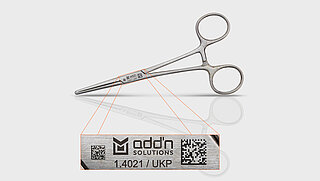Case Study
Safe through validation: Permanently reliable
readable codes on surgical instruments
Representative tests under actual conditions provide valid data that prove the long-term stability of the laser mark with an ultrashort pulse laser

Goal
The aim was to prove the long-term reliable durability of the marking, including UDI codes, of a medical device that had been reprocessed several times and to verify it in accordance with the ISO IEC 29158:2020-12 standard. The marking specialist add'n solutions conducted 100 cycles steam sterilizer autoclaving of instruments which had been laser marked with a USP laser and passivated during the final cleaning process.
Many Challenges
Directly marked UDI markings must neither impair the surface quality of the medical device nor corrode. To ensure the permanent traceability of the product, the labeling must reliably
outlast the entire product life cycle.
Particularly in the case of reusable medical devices, which are reprocessed several hundred times in everyday clinical practice, the resistance of direct labeling against sterilization and high alkaline cleaning processes is of utmost importance.
Only through a validated and coordinated process between marking parameters and subsequent cleaning and passivation a sustainable corrosion resistance of the marking itself as well as the the entire instrument can be guaranteed.
Download
You would like to learn more about the durability of laser marks with an ultrashort pulse laser on reusable medical products after reprocessing? You can download the complete representative study here.
| File Name | File Size | File Type |
|---|---|---|
|
Case Study "Safe through validation: Permanently reliable readable codes on surgical instruments"
.pdf,
795 KB
|
795 KB |